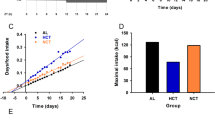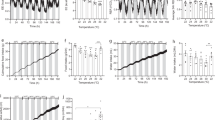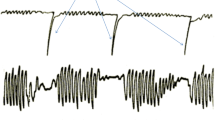Abstract
MOST omnivorous species exhibit a circadian rhythm of food intake. During one part of the day food is consumed at a rate in excess of immediate metabolic needs, and the surplus is stored to support metabolism for the remainder. Le Magnen and Devos1, for example, have shown a predominance of lipogenesis in the night-time feeding period of the rat, and pronounced lipolysis during the day, when little food is consumed. A variety of metabolic adaptations exists to match this discontinuous pattern of food intake with relatively constant metabolic use of nutrient2, but the question remains whether the hyperphagia at one time of day produces these changes or is a consequence of them. Le Magnen suggests the latter3, at least in the case of increased night-time meal frequency, and in models of feeding, such as that of Toates and Booth4, an increased rate of metabolic clearance of food at night is a considerable factor in promoting increased food intake. On the other hand, eating at a high rate clearly will promote metabolic changes, as bunching of the normal daily intake into a very short period will lead to increased weight gain5. A compromise possibility is that a greatly increased rate of feeding at dusk rapidly promotes metabolic changes subsequently favouring a high rate of feeding in the ways suggested by previous authors. The results reported here suggest that such a mechanism may operate in the feeding of mice, in that a great increase in feeding rate around the onset of darkness produces changes in carbohydrate metabolism which may both favour storage of energy and tend to increase subsequent food intake.
This is a preview of subscription content, access via your institution
Access options
Subscribe to this journal
Receive 51 print issues and online access
$199.00 per year
only $3.90 per issue
Buy this article
- Purchase on Springer Link
- Instant access to full article PDF
Prices may be subject to local taxes which are calculated during checkout
Similar content being viewed by others
References
Le Magnen, J. & Devos, M. Physiol. Behav. 5, 805–814 (1970).
Randle, M. J., Hales, C. N., Garland, P. B. & Newsholme, E. A. Lancet i, 785–789 (1963).
Le Magnen, J. in Hunger: Basic Mechanisms and Clinical Implications (eds Novin, D., Wyrwicka, W. & Bray, G. A.) (Raven, New York, 1976).
Toates, F. M. & Booth, D. A. Nature 251, 710–711 (1974).
Cohn, C. Ann. N. Y. Acad. Sci. 110, 395–407 (1963).
Petersen, S. A. Anim. Behav. 24, 939–955 (1976); IRCS med. Sci. 5, 373 (1977).
Weipkema, P. R. Behaviour 32, 179–210 (1968).
Steiner, D. F. & Freinkel, N. (eds) Handbook of Physiology, Section 7 (American Physiological Society, Washington, 1972).
Author information
Authors and Affiliations
Rights and permissions
About this article
Cite this article
PETERSEN, S. Feeding, blood glucose and plasma insulin of mice at dusk. Nature 275, 647–649 (1978). https://doi.org/10.1038/275647a0
Received:
Accepted:
Issue Date:
DOI: https://doi.org/10.1038/275647a0
Comments
By submitting a comment you agree to abide by our Terms and Community Guidelines. If you find something abusive or that does not comply with our terms or guidelines please flag it as inappropriate.



